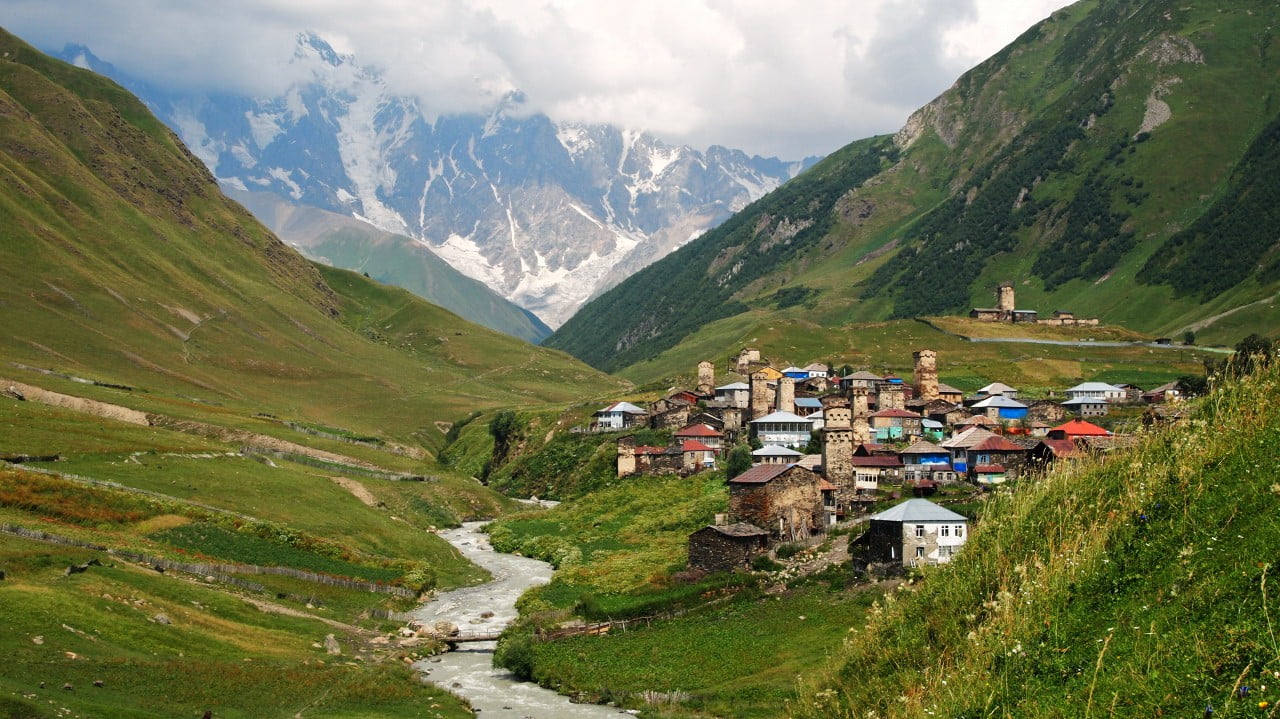At the height of 2191m, villagers in Ushguli, a small village in Georgia, can sometimes look down on the clouds. The population of Ushguli has carved out a home on the slopes of the Caucasian region, living in traditional homes in towers. At first glance, the rustic village looks hovel, but in reality, it is a wonderful place to live in. At least for the 200 citizens living in it. Ushguli is part of UNESCO heritage, and the village has its own school, and one of the oldest churches in Europe. The village is the highest place in Europe where people live all year around.
The community includes four villages, which are Zhibiani, Chvibiani, Murqmeli and Chazhashi. Located at the foot of Shkhara, which is one of the highest summits in the Caucasian region, the village is home for 70 families.
Popular hikes
One of the reasons why people visit the village, at least tourists, is the trekking and hiking routes. The village is home of one of the most beautiful hiking routes, the Ushguli-Shkhara glacier route. It takes approximately six hours for people to walk the whole rout in two ways, and the hike starts at the village of Ushguli.
The hiking route goes through the some stunning landscape, all to the Lamaria Church. One you get to the Lamaria church, you can experience the magnicificent views of the Mount Shkhara, the Ushguli village community and much more. Depending on visibility, the Mount Shkhara can be seen more or less.
The hiking route ends at an altitude of 2390 meters at the Shkhara glacier. It is there where the Inguri river originates just below the glaciaer. On the way back, you might get to see the Shkhara mountain in its full display, as the mountain reveals its beauty when the clouds go up.
If there is rain in the days before your journey or the day during your journey, you can expect a path that is a mixture of mud and cow puddles. Be careful, as hopping around rocks from one to another is a challenge. Wearing hiking boots is a must!
How to get there
As expected, there is no public transport to the village. Those who want to visit one of the highest villages in the world, will have to hire/rent a jeep. Often times, you might meet new people that are also asking for transport, and you might end up being the “public transportation” for other tourists. Listening to Svan songs as you are driving/going towards Ushguli is a common practice.
For those who want to stay several days, the Svaneti Mountaineering Tourism Center arranges home stays in the villages around Mestia.
A word of notice, even though the village is located high in the mountains, you can expect police officers on your way there. The police force is mostly friendly, but they must protect the village from usurpers and people trying to ruin the traditional and medieval look of the village.
![]()
UNESCO heritage
Uhsguli is part of a larger project by UNESCO in the Caucasian summits. The village is part of a Museum Reserve dating back to 1971. The boundaries of the protected landscape have changed, and it currently goes within 1km radius around the Ushguli village.
The protected zone has strict limitations for development activities, and the villages, including Chvbiani, Jibiani, Chazhashi and Murk’meli are listed as national monuments under the Georgian National Law of Cultural Heritage.
The two villages of Ushguli and CHazhashi have managed to preserve more than 200 tower houses from the medieval period, and have formed a community in the towers situated on the mountain slopes. The natural environment surrounding the two villages is breathtaking, but the highlight is the abundance of towers in the region.
In the villages, locals have managed to keep the traditional economic mode and the social organization of Svan communities.
The houses in the Ushguli region are also very authentic. They are two-storeyed, with the ground floor featuring single hall that accommodate people and domestic animals. Domestic animals are separated in the wooden partitions with lavish decorations. To help the thermal insulation, the houses feature corridor annex. The upper floor is designed for the human population during summer, and is also used as a storage section. The upper floor features a door that provides owners with access to the tower. The towers, and the houses within it serve as defense posts and dwellings.



